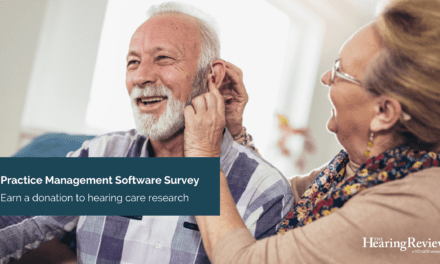All too often, individuals with hearing impairment choose less-than-optimal solutions or technology, stating price as their major reason. This compromise can lead to patient dissatisfaction and increased returns. Even worse, some clients who clearly need a hearing instrument ultimately opt not to purchase one due to financial reasons (eg, “my hearing still isn’t bad enough yet to warrant the cost of a hearing aid”).
According to MarkeTrak VI, about 1-in-3 (29.7%) hearing aid owners and 1-in-4 (24.4%) hearing aid non-owners have household incomes of less than $20,000 per year.1 Little wonder that price is tied for third-place in the factors that determine a consumer’s choice of a dispensing practice.2 Although the benefit of a hearing instrument far outweighs price in terms of influencing customer satisfaction, MarkeTrak VI data also suggests that the customer’s perception of hearing instrument value, satisfaction, and his/her likelihood of repurchasing an aid are all linked in complex ways to price.3
In many cases, the reluctance to pay for a top-of-the-line hearing instrument may have more to do with cash flow than affordability. Everyone has their pride. For the older client who relies on a fixed income and is suddenly confronted with an item that costs over $2,000, it can be easier to put off the decision “until the price gets better” and/or to seek a solution that is far less expensive—rather than explain their entire financial situation to a stranger. Most will be reluctant to convey their true reason for delaying the purchase, which may simply be they are unable to immediately access the necessary cash or do not have enough available credit on their consumer credit cards. And, if this is the case, they are not alone. Most Americans have only $300 available on their credit cards and find it difficult to write a check for more than $500 out of their monthly budget.
Their Financial Problem or Yours?
This leaves the hearing care professional with a problem. If you offer your clients a convenient, low monthly payment plan, more will accept optimal technology. Returns should decrease, and revenues should increase. Unfortunately, when you take on the responsibility of billing clients, you also incur the costs of billing and the hassles that come with it, including the costs of collection and uncollectable accounts. Therefore, there is a possibility that, even though your revenues increase, the costs of billing and carrying accounts receivables may offset this profitability.
One available solution is integrating a third-party financing program into your practice. With a third-party financing program, you can offer clients a wide variety of monthly payment plans—even some that offer interest-free financing. This allows more clients to accept optimal treatment plans. Plus, with the right third-party financing partner, you receive the full treatment fee (less a small processing fee) within a few business days. Finally, with some third-party financing partners, you are not responsible if your client delays payment or defaults.
Presenting Third-Party Payment Programs to Clients
The practical success of using a third-party financing program revolves around the way you and your staff present the option to clients. To optimize this program, you should present third-party financing to all clients as one of their financial choices during the treatment discussion. It is often effective to present the treatment or technology cost as a monthly payment, in addition to the total fee (eg, “Mr. Smith, this hearing instrument will run you about $68 a month should you opt for financing, or $2,500 total.”) This is often more manageable for the client.
Even though some clients may not choose the financing plan, by presenting this option you have eliminated another obstacle toward the purchase of the hearing instrument, alleviated some of the immediate psychological strain on the client (ie, his/her mind whirring about where they’re going to get the money to pay for the aid), and given him/her another way to access the best possible hearing solution (ie, the one that you’re recommending). Additionally, alternative payment options can be promoted in your practice’s literature, advertising, marketing efforts, and hearing care orientation materials.
Third-party financing can help you increase acceptance of optimal technology, reduce return rates, and increase cash flow and revenue, while increasing customer satisfaction with hearing instruments.

|
References
1. Kochkin S. MarkeTrak VI: The VA and direct mail sales spark growth in hearing aid market. Hearing Review. 2001;8(12):63-65.
2. Kochkin S. MarkeTrak VI: Factors impacting consumer choice of dispenser and hearing aid brand; use of ALDs and computers. Hearing Review. 2002;9(12): 14-23.
3. Kochkin S. MarkeTrak VI: On the issue of value: Hearing aid benefit, price, satisfaction, and brand repurchase rates. Hearing Review. 2003;10(2):12-26.





